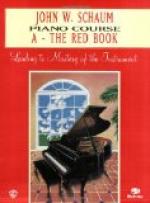How much time does the artist really require for study? Paderewski owns to devoting all his time to it during the periods of preparation for his recital tours. At certain seasons of the year most of the artists give a large portion of each day to the work. Godowsky is an incessant worker; Burnham devotes his entire mornings to piano study; Germaine Schnitzer gives six hours daily to her work, and if interrupted one day the lost time is soon made up. Eleanor Spencer “practises all her spare time,” as she quaintly puts it. A professional pianist must give a number of hours each day to actual practise at the keyboard, besides what is done away from it. The work is mentally going on continually, whether one really sits at the instrument or not.
The point which most concerns us is: How shall one practise so as to make the most of the time and accomplish the best results? What etudes, if any, shall we use, and what technical material is the most useful and effectual?
Wilhelm Bachaus, whose consummate technic we have so often admired, says: “I am old-fashioned enough to still believe in scales and arpeggios. Some of the players of the present day seem to have no use for such things, but I find them of great importance. This does not necessarily mean that I go through the whole set of keys when I practise the scales. I select a few at a time and work at those. I start with ridiculously simple forms—just the thumb under the hand and the hand over the thumb—a few movements each way, but these put the hand in trim for scales and arpeggios. I practise the latter about half an hour a day. I have to overhaul my technic once or twice a week to see that everything is in order. Scales and arpeggios come in for their share of criticism. I practise them in various touches, but oftener in legato, as that is more difficult and also more beautiful than the others. I practise technic, when possible, an hour a day, including Bach.”
Sigismond Stojowski considers that scales and arpeggios must form a part of the daily routine.
Thuel Burnham says: “Of my practise hours at least one is given to technic, scales, arpeggios, octaves, chords, and Bach! I believe in taking one selection of Bach and perfecting it—transposing it in all keys and polishing it to the highest point possible. So with etudes, it is better to perfect a few than to play at so many.”
THE PIANIST A MECHANIC
Edwin Hughes, the American pianist and teacher in Munich, remarks: “Technic is the mechanical part of music making; to keep it in running order one must be constantly tinkering with it, just as the engine driver with his locomotive or the chauffeur with his automobile. Every intelligent player recognizes certain exercises as especially beneficial to the mechanical well-being of his playing; from these he will plan his daily schedule of technical practise.”




